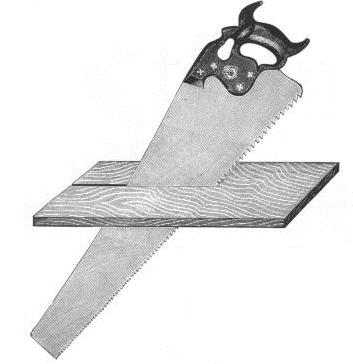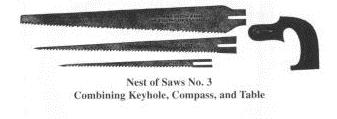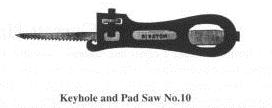

"What's in a Name?" Part II
Compass Saw? Table Saw? Keyhole and Pad Saw?
Pete Taran
 There are many different types
of saws that can be used in the shop to accomplish various cutting
tasks. In the last article, we talked about the more common back,
hand and rip saws. This time we will cover how compass, table,
and the keyhole and pad saws can be used to augment the saws that
you already have and increase productivity.
There are many different types
of saws that can be used in the shop to accomplish various cutting
tasks. In the last article, we talked about the more common back,
hand and rip saws. This time we will cover how compass, table,
and the keyhole and pad saws can be used to augment the saws that
you already have and increase productivity.
Compass saws are used primarily for cutting out holes on the interior of a board, but their thin tapered blade also allows them to be used to cut a curve on the exterior of a board.
Compass saws were available with blade lengths from 10 to 18 inches. There are virtually as many different types of compass saw construction as there are compass saws. Some have fixed handles with the blade fastened to the handle with two standard brass saw screws. Others have removable blades via a thumb or cam operated lever screw that allows for different pitch and length blades to be used with the same handle. Regardless of the method of attachment, the role of the saw remains the same. The blade on the compass saw is of very heavy gauge material that tapers from about 1 1/2" to a blunt point. Since the blade has no means of stiffening, and is already thin and prone to bending, the steel is quite a bit heavier than even that encountered on regular handsaws. Since in the course of cutting a circle, the saw encounters both ripping and cross cutting type cuts, the teeth on the compass saw are a combination of the two. While the profile more resembles rip teeth, they are sharpened with a fleam angle like crosscut saw teeth. The result is a saw that can cut in both types of grain, although with less efficiency than if it were one or the other.
Using a compass saw is tedious at best. The thick blade is
made thicker by the set of the teeth which allows the saw to move
in the kerf it creates. This kerf is quite wide, usually about
3/32". Since the teeth are a compromise when ripping with
or cutting across the grain, cutting with a compass saw is slow
work. This type of saw works best  if the
blade is kept sharp and properly set. Once the saw begins to dull,
it binds very easily, and since the blade is narrow, kinks quite
easily. Finding a good compass saw on the old tools market is
a challenge. Since they are so easily damaged, finding one with
a straight, unkinked blade can be difficult. The good news is
that these saws can be straightened with a fair degree of success.
Since they are so plentiful, look for one that has a comfortable
handle and a blade that is relatively straight. To have a first
class compass saw setup, consider finding two compass saws that
have similar thickness blades. Sharpen one with true rip teeth,
and sharpen the other with true crosscut teeth. When cutting a
circle, drill a hole on the inside perimeter of the work and begin
cutting with the appropriate saw, the cross cut, or the rip. When
the grain starts to change direction, switch to the other saw.
Using a pair of compass saws in this manner greatly increases
the efficiency of the cut and the surface finish of the work.
if the
blade is kept sharp and properly set. Once the saw begins to dull,
it binds very easily, and since the blade is narrow, kinks quite
easily. Finding a good compass saw on the old tools market is
a challenge. Since they are so easily damaged, finding one with
a straight, unkinked blade can be difficult. The good news is
that these saws can be straightened with a fair degree of success.
Since they are so plentiful, look for one that has a comfortable
handle and a blade that is relatively straight. To have a first
class compass saw setup, consider finding two compass saws that
have similar thickness blades. Sharpen one with true rip teeth,
and sharpen the other with true crosscut teeth. When cutting a
circle, drill a hole on the inside perimeter of the work and begin
cutting with the appropriate saw, the cross cut, or the rip. When
the grain starts to change direction, switch to the other saw.
Using a pair of compass saws in this manner greatly increases
the efficiency of the cut and the surface finish of the work.
 When the word "table saw"
is mentioned, an image comes to mind of an electrically operated
circular saw mounted in a cast iron frame. Few might realize that
a compass type saw used this name long before it was associated
with its more dangerous name sake. A table saw looks like a compass
saw on steroids. The blade was offered in 12" to 26"
inch lengths and it was fitted with an open style handle more
commonly found on dovetail saws. They were available in both crosscut
and rip tooth style configurations. A table saw, as the name suggests,
was used to cut along the circumference of a round table, or for
any other curved work that needed to be done on the outside of
a curve. It is interesting to note, that in some saw catalogs,
this saw was more completely termed "Table and Pruning Saw."
While the wider blade does resemble a pruning saw, it is hard
to imagine using a saw with such a finely fitted handle outside
to trim the apple tree! Since most pruning saws cost roughly the
same as table saws, I suspect that the saw manufacturers tried
to offer this saw as a two in one type product to entice customers
who might be able to use the saw in both roles. It is hard to
imagine the cabinetmaker/orchard owner population was that large
however. Not surprisingly, these saws are quite rare on the old
tools market. They work well in both roles, but like any unsupported
saw, should be kept sharp and used with care. A related type of
saw used for very different work is the keyhole and pad saw.
When the word "table saw"
is mentioned, an image comes to mind of an electrically operated
circular saw mounted in a cast iron frame. Few might realize that
a compass type saw used this name long before it was associated
with its more dangerous name sake. A table saw looks like a compass
saw on steroids. The blade was offered in 12" to 26"
inch lengths and it was fitted with an open style handle more
commonly found on dovetail saws. They were available in both crosscut
and rip tooth style configurations. A table saw, as the name suggests,
was used to cut along the circumference of a round table, or for
any other curved work that needed to be done on the outside of
a curve. It is interesting to note, that in some saw catalogs,
this saw was more completely termed "Table and Pruning Saw."
While the wider blade does resemble a pruning saw, it is hard
to imagine using a saw with such a finely fitted handle outside
to trim the apple tree! Since most pruning saws cost roughly the
same as table saws, I suspect that the saw manufacturers tried
to offer this saw as a two in one type product to entice customers
who might be able to use the saw in both roles. It is hard to
imagine the cabinetmaker/orchard owner population was that large
however. Not surprisingly, these saws are quite rare on the old
tools market. They work well in both roles, but like any unsupported
saw, should be kept sharp and used with care. A related type of
saw used for very different work is the keyhole and pad saw.
 A keyhole and pad saw is used for
cutting interior circles and other shapes that are much smaller
than an ordinary compass saw could accomplish, hence the name
"keyhole." The "pad" refers to the handle
of the saw which holds the blade. For brevity, we'll just called
them keyhole saws. Some keyhole and pad saws resemble compass
saws with the exception that they have very thin delicate blades
no more than 3/8 of an inch wide at their widest points. These
saws are generally found with 10 to 14 inch blades. Of all the
various types of keyhole saws, these are the least desirable since
the entire length of blade is exposed during the cutting operation.
Since these blades are so fine and thin, they kink very easily
if not properly used.
A keyhole and pad saw is used for
cutting interior circles and other shapes that are much smaller
than an ordinary compass saw could accomplish, hence the name
"keyhole." The "pad" refers to the handle
of the saw which holds the blade. For brevity, we'll just called
them keyhole saws. Some keyhole and pad saws resemble compass
saws with the exception that they have very thin delicate blades
no more than 3/8 of an inch wide at their widest points. These
saws are generally found with 10 to 14 inch blades. Of all the
various types of keyhole saws, these are the least desirable since
the entire length of blade is exposed during the cutting operation.
Since these blades are so fine and thin, they kink very easily
if not properly used.
 A far superior type of keyhole
saw incorporates a handle which is slotted all the way through,
allowing only the length of blade to protrude that will be needed
for the cutting task at hand. It is best to keep the bulk of the
cutting activity right up near the handle where it is best supported.
The farther away from the handle the blade gets, the more it flexes
and the more easily it is kinked. There are several different
types of handles that allow the blade to be concealed and extended
to the proper length. One less common type is a round wooden handle
with a ferrule and thumb screw which is slotted along it's entire
length. Most of these types of saws came equipped with 10 inch
blades, about half of which was concealed by the handle in normal
storage and use. A far more common type of keyhole saw is one
which uses a cast iron handle which is open. The blade slides
along a track milled in one side of the handle and is adjusted
by a wing nut or cam operated lever. These
A far superior type of keyhole
saw incorporates a handle which is slotted all the way through,
allowing only the length of blade to protrude that will be needed
for the cutting task at hand. It is best to keep the bulk of the
cutting activity right up near the handle where it is best supported.
The farther away from the handle the blade gets, the more it flexes
and the more easily it is kinked. There are several different
types of handles that allow the blade to be concealed and extended
to the proper length. One less common type is a round wooden handle
with a ferrule and thumb screw which is slotted along it's entire
length. Most of these types of saws came equipped with 10 inch
blades, about half of which was concealed by the handle in normal
storage and use. A far more common type of keyhole saw is one
which uses a cast iron handle which is open. The blade slides
along a track milled in one side of the handle and is adjusted
by a wing nut or cam operated lever. These  saws
are slightly less comfortable to use, but are certainly plentiful
on the old tools market. Another great virtue of these saws is
that since you only use the very end of the blade, when it gets
dull or breaks of its own accord during use, it is a simple matter
of extending the blade a few more inches and continue cutting.
The blades on these saws are almost always filed crosscut, but
since the amount of wood removed is small, this is not an inconvenience
when doing rip type cuts. While the cutting of circles and other
complex curves is not something that is required every day, when
the task arises, nothing will rise to challenge better than a
properly sharpened compass type saw.
saws
are slightly less comfortable to use, but are certainly plentiful
on the old tools market. Another great virtue of these saws is
that since you only use the very end of the blade, when it gets
dull or breaks of its own accord during use, it is a simple matter
of extending the blade a few more inches and continue cutting.
The blades on these saws are almost always filed crosscut, but
since the amount of wood removed is small, this is not an inconvenience
when doing rip type cuts. While the cutting of circles and other
complex curves is not something that is required every day, when
the task arises, nothing will rise to challenge better than a
properly sharpened compass type saw.
Photos from 1918 catalog of the Henry Disston & Sons, Philadelphia, PA